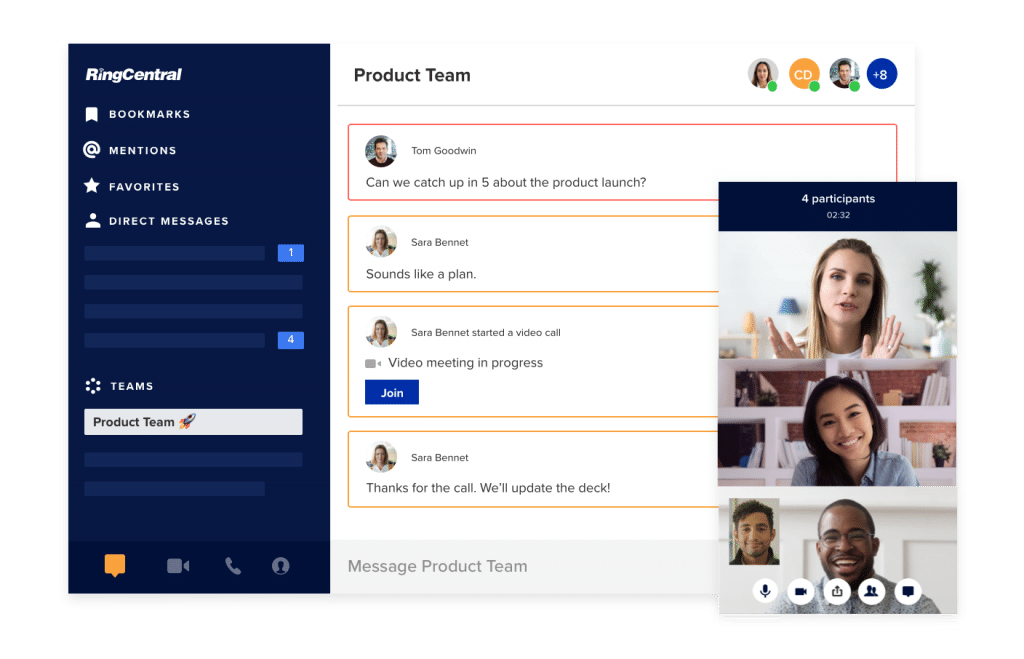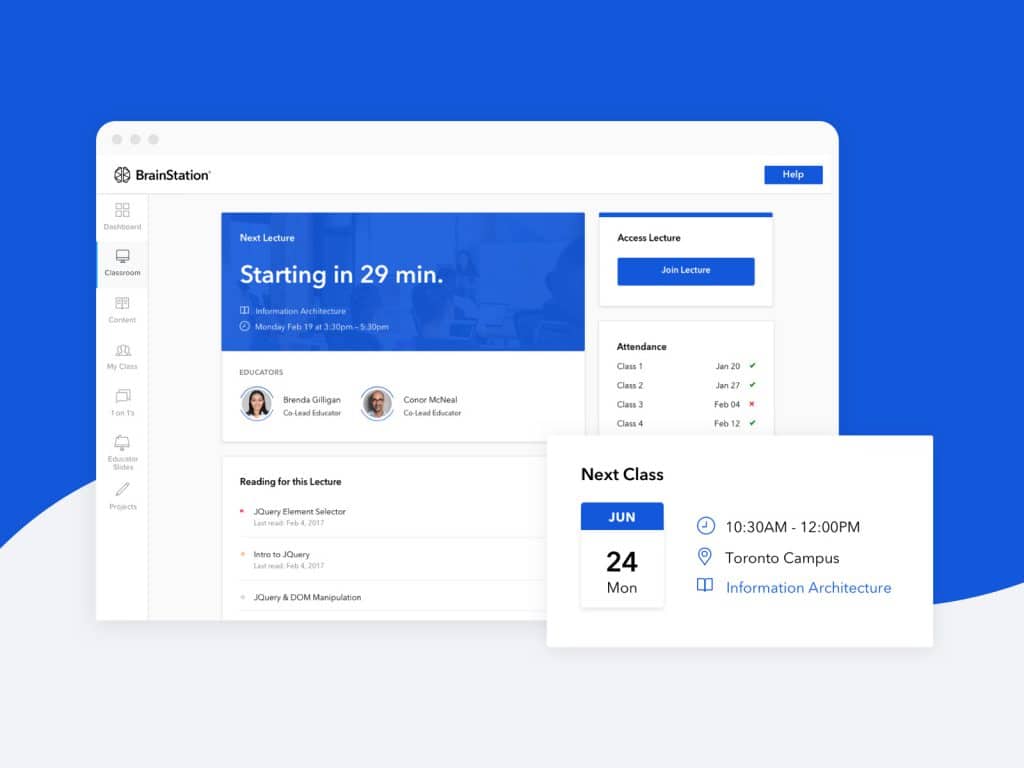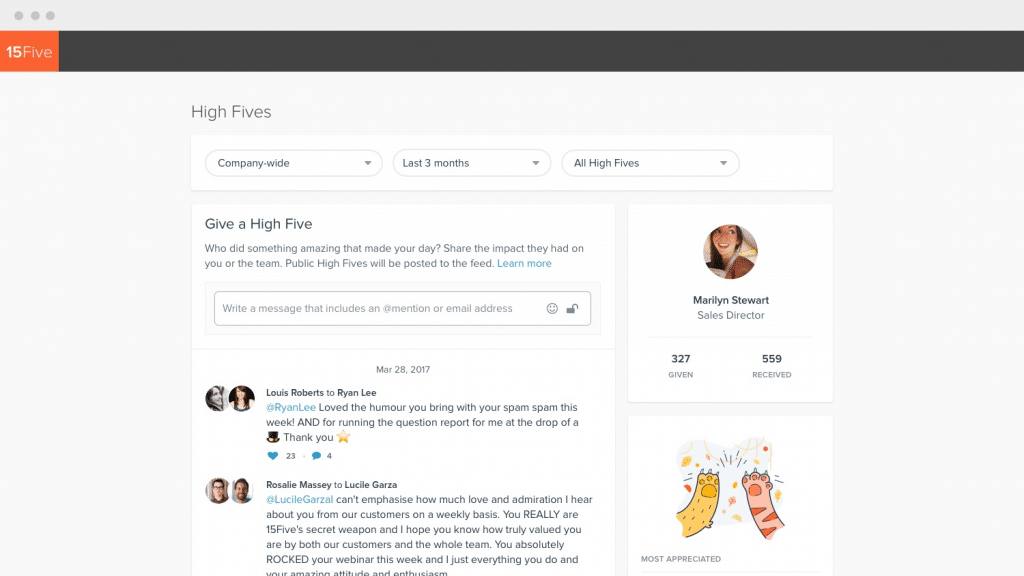Small businesses understand the importance of customer retention better than anyone. But do you have a blind spot when it comes to retaining your employees?
Decreasing employee turnover rate can be difficult, especially when you’re on a tight budget. And it doesn’t help that there are a wide variety of reasons your employees may be looking for a new job. If you want to excel at employee retention, you have to be familiar with all the little details that make up the big picture when it comes to job satisfaction.
Now, you might be thinking: Employee retention strategies sound pretty costly—I’m just a small business! But they’re actually not about hefty bonuses that you can’t afford to offer your team members. Employee retention is about so much more than expensive perks. Businesses of any size can, and should, take steps to foster loyalty throughout their team. And we’ve got some affordable ideas to help you get started.
What we’ll cover:
- What is employee retention?
- The high cost of employee turnover
- 7 low-cost ways to improve employee retention
✍️ Need help building better employee reviews? ✍️
We made you a template that’s competency based and includes specific criteria for remote team members!
What is employee retention, exactly?
Simply put, employee retention is the ability of a business to keep its employees on board. Businesses will always experience some employee turnover. But on a deeper level, retention is about employee engagement and job satisfaction.
According to Emplify, 73% of current employees are open to a new career opportunity. And 33% are actively seeking a new job.
Think of employee retention as a verb, not a noun. Businesses must work to motivate and engage each team member. Companies that actively seek to give more to their employees will get more back in return. And companies that do the bare minimum will bleed talent.
The high cost of employee turnover
MYTH: As a small business owner, you can’t afford to focus on employee retention strategies right now.
FACT: As a small business owner, you can’t afford to ignore employee retention.
According to a Glassdoor survey, 35% of hiring managers and HR staff expect new hires to quit within just 12 months. But what are they doing to improve their retention?
As a business owner, you know that getting a new customer is more costly than keeping an existing one. The same is true when it comes to your employees. According to the Society of Human Resource Management (SHRM), it can cost 6 to 9 months’ salary to replace an employee if they leave.
That’s time and money spent on job postings, interviews, and onboarding—efforts not used on day-to-day operations (meaning they’re not that valuable). And don’t forget all the projects that screech to a halt while you try to fill positions.
Add to this the close supervision, training, and assistance new employees need (and also the increased potential for errors as they learn). These extra measures and mistakes mean more lost time and money for your business.
There are many ways to reduce employee turnover. Offering at or above market rate salaries is just one potential solution. A healthcare plan, bonuses, and stock options are other important perks that companies should consider. But some businesses simply can’t fund these types of benefits.
Luckily, there are some easy, affordable ways to improve employee morale and job satisfaction, and diverse methods to build a team that is happy, healthy, and on board long-term. If you enact them, your company culture will be much more likely to attract top talent. Then, with the right employees, your business can expect a healthier bottom line.
| How to know if these retention techniques are working: Fewer employees will be looking for the exit. And you’ll see more positive results in your employee experience surveys. Effective employee retention strategies come with a lot of other “fringe benefits” for both your team and your business. |
7 low-cost ways to improve work flexibility—and employee retention
For creative business owners, there are many ways to create a flexible workplace and culture that encourages retention. And it doesn’t always involve lots of spending.
1. Start at the beginning.
“This isn’t what I signed up for!” is a great tagline for the exasperated sidekick in an action movie. But it’s not something you want an employee thinking when a new project hits their desk. Unmet expectations can have a costly impact on retention, productivity, creativity, and collaboration, as well as mental health.
Learn more about productivity metrics and how to measure them.
The best employee retention strategies start with the hiring process. Start with job postings and interviews that outline the scope and nature of the position with clarity. Explain your company culture. Give an honest picture of the potential for growth. That way, candidates can have realistic expectations and make an informed decision.
And do your homework! A candidate’s resume is full of vital retention information if you know how to read it. You’re likely to have better luck with someone who has put in solid time at one company instead of jumping to a new job every three months.
A great onboarding process leads to great employees. Effective guidance will save you from trainee errors and other productivity slowdowns. Plus, it will give your new hires the confidence they need to feel at home and empowered in your organization.
Make use of coworker mentorships. The veterans can effectively guide new hires and provide honest expectations. But the experienced employees will also benefit from a fresh pair of eyes. The new team members may even coax some new ideas from their coworkers.
The fringe benefits: You’ll spend less time and money fixing mistakes by newcomers… and finding their replacements.
2. Engage your introverts.
Are you only hearing the first and loudest voices in the room? Chances are you might be overlooking your introverted employees… and pushing them out the door.
If you have employees in your office who rarely speak up in your regular meetings, that doesn’t mean they have nothing to say. They might be introverts. And they might just be your most valuable employees.
These are people who keep their thoughts internal, and recharge their batteries by spending time alone. This is in contrast to extroverts. Those who express their thoughts out loud and get energy from being with others.
Most offices today are set up to reward and recognize extroverts. But Forbes.com has proclaimed introverts the “quiet powerhouses” of the workplace. So how can you tap into this natural resource? Especially if you have a remote team?
Engaging introverts at work is actually both easy and affordable. Don’t wait to find out what they are thinking until their exit interviews!
- Avoid back-to-back meetings whenever possible. Give everyone a chance to recharge so they can bring their best to each conversation. Many introverts will find it easier to share ideas when given time to consider them from every angle first.
- Give them more time. Being able to write their thoughts down helps introverts with their workflow. Make use of file-sharing tools. Cloud-based tools allow employees to go back and review items on their own time. And many productivity tools allow for employee feedback on projects and leadership.
- Use technology. Encourage the sharing of ideas in writing via email or a team messaging app. Encourage the sharing of ideas in writing via email or a team messaging app like RingCentral, which allows folks to chat in real time from any device, whenever inspiration strikes, and feel seen:
- Promote flexibility. Allow employees to choose which communication channel works best for them. They should be able to have flexibility in terms of communication whether it’s through instant messaging or audio calls. With the many tech options available, flexibility in communication will eventually lead to happy employees.
The fringe benefits: You’ll see more engagement and input from your quietest employees. You will gain diverse and brand-new insights that propel your business forward.
3. Give employees the information and the right tools to do their jobs.
We’ve all seen it. You go to a meeting with the whole team. The bosses relay a well-thought out plan and delegate. Afterward, you sit down to get stuck in and realize you can’t execute. Now why is that? Well, you don’t have the information or the right tools for the task at hand.
Now, we’re all aware of the pitfalls of being a micromanager. Avoid that path at all costs. Instead, encourage your team to solve problems by working together. But to do that, you have to give them the right tools. Otherwise, they will find it difficult to deliver what you want. They’ll still get the job done—they’re your dream team, after all—but it may be through long hours and an arduous and roundabout process.
So, how can you be a good boss—without being overbearing? Give your employees a flexible solution for cross-team collaboration and communication. Encourage teamwork with a team messaging app that they can use to send each other messages and create project-based groups to stay organized:
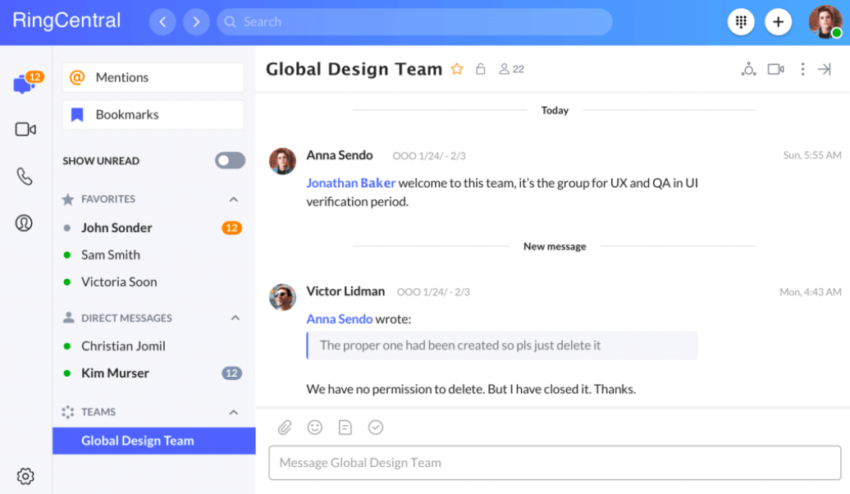
An added bonus of having team apps like this is that it gives your team more flexibility on when and from where they can work. All they need is their computer or phone.
So, what can you do if you want to give your team more effective channels of communication with each other? Well, there are many cloud-based software options that allow you to message, video call, and phone other folks (all within the same app). Which sounds nice, but it also helps you save money too since you don’t have to pay for multiple disparate tools.
Take RingCentral Office, for example. Not only does it give you messaging, video conferencing, and a business phone service, it also has built-in file sharing…

And even task management. Need to help your team sort out their tasks and stay on schedule? You can create, assign, and even color-code tasks in the RingCentral app, right in your group or team chat:
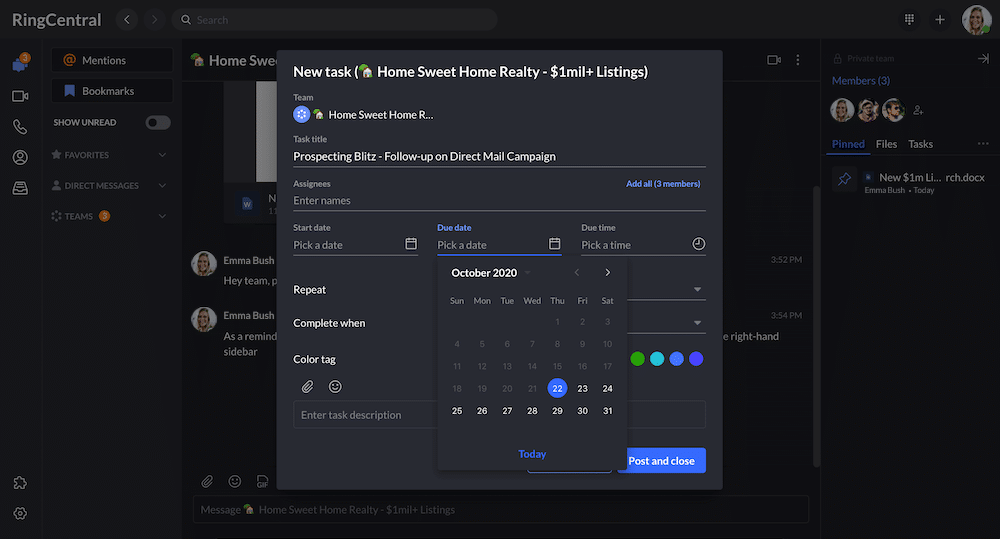
And yes, the app comes in Dark Mode too.
Sounds like a lot of fancy features, but the end goal is simple: To make sure your employees feel empowered to do their work. (And improve retention rates, of course!)
An online workspace can be a real boon for productivity by making it easier for employees to do their work. But you shouldn’t stop there. Today, the internet is full of amazing online tools that can help in all areas of your business.
Take customer support for instance. Of course, you can establish friendly service through proper recruiting, hiring, and training. But what about fast and effective customer service? A platform like RingCentral Engage Digital can make this easier for your team whether they’re working remotely or in the office. During any call, the platform can display relevant data related to customer relationship history, making it easier for the contact team to identify and fix any problems:
The fringe benefits: You’ll have improved turnaround time on complex projects and less confusion between teams. This gives your customer service team the time to do their job effectively. All this makes for happy customers because they’ll get faster results and fewer mistakes!
4. Nurture psychological safety (key to employee wellness).
Science has spoken: employees who feel a strong sense of psychological safety are more engaged, productive, and loyal to their company, according to Harvard Business School’s Professor Amy C. Edmonson. “Psychological safety” sounds daunting, but what it really means is inclusion, something that’s easier to nurture within your organization than you might think.
Here are a few ways to do that:
- Set the tone for inclusion. Create a sense of belonging by setting the example. Bake the importance of psychological safety into your onboarding process by implementing online courses in inclusion and unconscious bias. And be sure to take these courses yourself!
- Give everyone a voice. In addition to the strategies for introverts listed above, employee engagement surveys are another great way to take the pulse of your organization. Be sure to include a few questions geared toward psychological safety, like: “Do you feel comfortable bringing your whole self to work?” and “Do you feel your voice and input are valued?” Ask the same questions year over year (or however often you plan to survey) to get the clearest data. Surveying your team doesn’t have to be time or cost prohibitive, thanks to helpful tools like Qualtrics and SurveyMonkey that track and compile the responses for you.
- Rinse and repeat. Inclusion and belonging aren’t just boxes you check; they are ongoing processes that enrich your team, encourage loyalty, and improve morale. Make inclusion part of your strategic plan, with regular check-ins and evaluation. You can even appoint and train an “Inclusion Ambassador,” someone on your team who has shown interest and can spend a small amount of time reading up on the topic and sharing information with their colleagues. Psychological safety and professional development in one!
The fringe benefits: Increased focus on psychological safety should result in greater productivity and participation, especially in folks from underrepresented communities who bring valuable thought diversity to the table.
5. Create opportunities for professional growth.
Investing in your team is a net positive for everyone, and it doesn’t have to break the bank. Career development is one way to help employees feel valued and engaged. It can be as simple as offering stretch projects to standout employees or the chance to lead a small team on a new office initiative. Paying for professional qualifications and certifications can also be mutually beneficial.
You might opt for low-cost online courses through Brainstation or Coursera, or send employees to local conferences. You could even fund a subscription to the professional publication of their choosing. However you choose to do it, getting employees actively learning will make them more engaged with the company.
It’s also important to share how growth happens in your business. Transparency about advancement opportunities is an important factor—you want your employees to see how they can advance their careers, which can go a long way in helping you increase employee retention.
Create a leadership ladder so employees understand the hierarchy and what they need to do to move up. This can be a simple flowchart or timeline of the promotion process. Make employee career plans part of your annual review process and share important team knowledge. And you will know how best to support each team member in their pursuits.
The fringe benefits: You’ll see more employees taking advantage of the professional development opportunities you offer. And in return, they will be putting that knowledge to work solving problems on the job.
6. Celebrate a job well done.
There’s a proven connection between employee recognition and greater retention rates. It makes sense: people stay where they feel valued and appreciated.
And the best approach to employee recognition? It just might be a creative one. Think about ways to get your whole team involved in showing appreciation for one another. Keep a whiteboard where team members can write compliments to one another. Or instead, use an online whiteboard or group chat tool.
The easier it is to use, the greater the participation you will get. Many collaboration and productivity tools will have appreciation functions. Some platforms come ready to integrate with employee-recognition tools like 15Five and Kudos.
Peer recognition outlets are important. But don’t forget to implement some more formal, leadership-driven appreciation! Heartfelt acknowledgment from the boss can go a long way toward keeping your best and brightest. Also, take the team out to lunch or for drinks as a reward. The costs of these activities will be far outweighed by their benefits.
The fringe benefits: You’ll get enthusiastic participation and create a culture of appreciation. Employees will reward appreciation with more engagement.
Learn more about collaborative leadership.
7. Focus on work-life balance and provide greater work flexibility.
Today’s workforce is less motivated by titles, and more interested in the work environment. Some small businesses might not be able to offer a competitive salary, but they can offer a competitive lifestyle.
What you can’t afford in bonuses or an employee’s salary, make up for in a commitment to employee wellness and other non-monetary perks. Say “yes” to modified workweek schedules, like four 10-hour days and flextime. Say “no” to emails after 5:00 p.m. Work with parents of young children on flexible schedules.
Implement telecommuting with the help of all-inclusive, cloud-based tools that keep everyone in the loop. RingCentral has a plethora of options to help your business run remotely. You and your team will have all of the lifestyle benefits from being able to work from anywhere. But you can expect to see an increase in productivity with effective collaboration tools like online file-sharing and storage. But also via effective communication tools like HD video conferencing and team chat messaging.
The fringe benefits: A commitment to work-life balance will attract an even wider pool of talent to your door—top talent who have incredible skill sets but can’t be in the office every weekday from 9 to 5.
Employee retention strategies don’t have to break the bank
Employee retention strategies are good for business, and they don’t have to bust your budget. It starts with a little creative thinking. And with the help of affordable and versatile employee engagement apps, you can build a loyal team that will take your success to the next level. And the work you do will attract better talent, boost employee morale, and improve your customer experience.
RingCentral offers affordable, one-stop-shop communications and productivity, cloud-based tools that allow your team to connect and collaborate like never before. Get a hands-on look at how RingCentral works by booking a product tour:
💰 You can also use this calculator to see roughly how much your business could save by using RingCentral to support your team’s communication with each other, clients, freelancers, and more.
Originally published Feb 02, 2021, updated Jun 19, 2024


